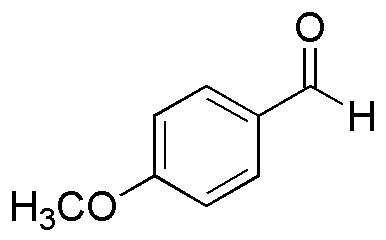p-Anisaldehyde is widely utilized in research focused on:
- Flavor and Fragrance Industry: Commonly used as a flavoring agent in food products and as a scent in perfumes, it provides a sweet, floral aroma that enhances consumer appeal.
- Synthetic Organic Chemistry: Serves as a key intermediate in the synthesis of various organic compounds, including pharmaceuticals and agrochemicals, facilitating the development of new drugs and crop protection agents.
- Analytical Chemistry: Employed as a reagent in various analytical techniques, such as chromatography, to help identify and quantify other compounds in complex mixtures.
- Polymer Production: Utilized in the production of certain polymers and resins, contributing to materials with enhanced properties, such as improved durability and resistance to environmental factors.
- Biological Research: Investigated for its potential biological activities, including antimicrobial and antioxidant properties, which can lead to the development of new therapeutic agents.
Informations générales
Propriétés
Sécurité et réglementation
Applications
p-Anisaldehyde is widely utilized in research focused on:
- Flavor and Fragrance Industry: Commonly used as a flavoring agent in food products and as a scent in perfumes, it provides a sweet, floral aroma that enhances consumer appeal.
- Synthetic Organic Chemistry: Serves as a key intermediate in the synthesis of various organic compounds, including pharmaceuticals and agrochemicals, facilitating the development of new drugs and crop protection agents.
- Analytical Chemistry: Employed as a reagent in various analytical techniques, such as chromatography, to help identify and quantify other compounds in complex mixtures.
- Polymer Production: Utilized in the production of certain polymers and resins, contributing to materials with enhanced properties, such as improved durability and resistance to environmental factors.
- Biological Research: Investigated for its potential biological activities, including antimicrobial and antioxidant properties, which can lead to the development of new therapeutic agents.
Documents
Fiches de données de sécurité (FDS)
La FDS fournit des informations de sécurité complètes sur la manipulation, le stockage et l’élimination du produit.
Spécifications du produit (PS)
Le PS fournit une description complète des propriétés du produit, notamment sa composition chimique, son état physique, sa pureté et les exigences de stockage. Il détaille également les plages de qualité acceptables et les applications prévues du produit.
Certificats d'analyse (COA)
Recherchez des certificats d'analyse (COA) en saisissant le numéro de lot du produit. Les numéros de lot et de lot se trouvent sur l'étiquette d'un produit, après les mots « Lot » ou « Lot de fabrication ».
Numéro de catalogue
Numéro de lot/série
Certificats d'origine (COO)
Ce certificat d'exploitation confirme le pays dans lequel le produit a été fabriqué, et détaille également les matériaux et composants utilisés et s'il est issu de sources naturelles, synthétiques ou autres sources spécifiques. Ce certificat peut être requis pour les douanes, le commerce et la conformité réglementaire.
Numéro de catalogue
Numéro de lot/série
Fiches de données de sécurité (FDS)
La FDS fournit des informations de sécurité complètes sur la manipulation, le stockage et l’élimination du produit.
DownloadSpécifications du produit (PS)
Le PS fournit une description complète des propriétés du produit, notamment sa composition chimique, son état physique, sa pureté et les exigences de stockage. Il détaille également les plages de qualité acceptables et les applications prévues du produit.
DownloadCertificats d'analyse (COA)
Recherchez des certificats d'analyse (COA) en saisissant le numéro de lot du produit. Les numéros de lot et de lot se trouvent sur l'étiquette d'un produit, après les mots « Lot » ou « Lot de fabrication ».
Numéro de catalogue
Numéro de lot/série
Certificats d'origine (COO)
Ce certificat d'exploitation confirme le pays dans lequel le produit a été fabriqué, et détaille également les matériaux et composants utilisés et s'il est issu de sources naturelles, synthétiques ou autres sources spécifiques. Ce certificat peut être requis pour les douanes, le commerce et la conformité réglementaire.


